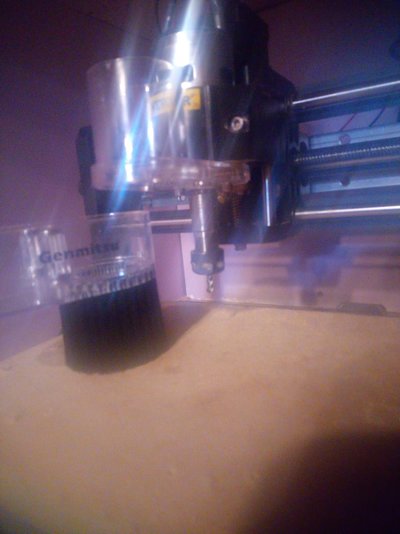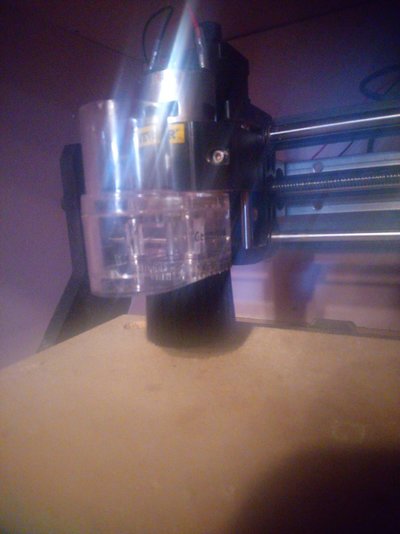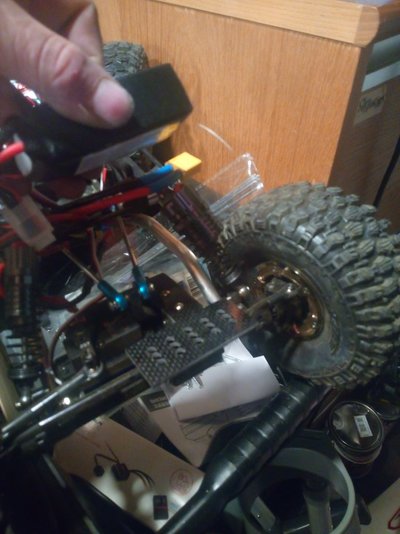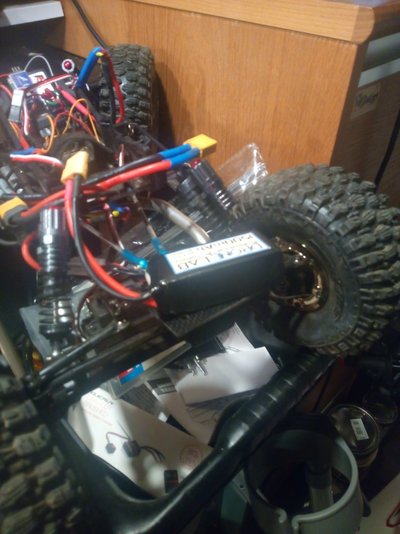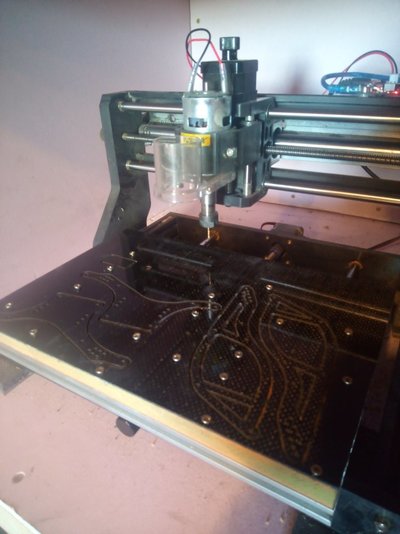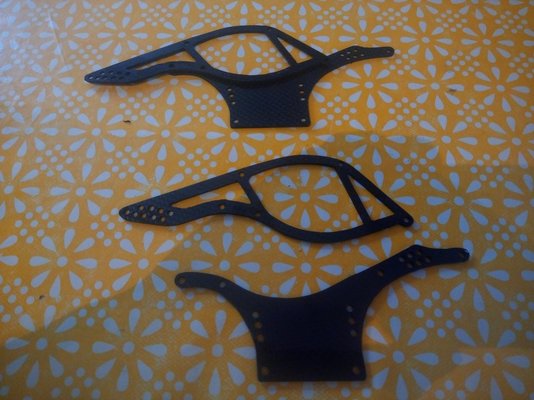I could only get NO to work with my board. What board are you using?
You are using an out of date browser. It may not display this or other websites correctly.
You should upgrade or use an alternative browser.
You should upgrade or use an alternative browser.
CNC Router Engraver - Software Question
- Thread starter My Old Landy
- Start date
eLuSiVeMiTe
Member
- Messages
- 16,282
- Location
- ......
Grbl Arduino based I believe.I could only get NO to work with my board. What board are you using?
Has ports for them on the board already and the option to swap no to NC iirc
eLuSiVeMiTe
Member
- Messages
- 16,282
- Location
- ......
eLuSiVeMiTe
Member
- Messages
- 16,282
- Location
- ......
Trials and tribulations.
Pocket holes went well.
Workholding not so much.
4 holes around the outside and screwed down with double sided tape holding the middle.
Must have let go as the tabs were cut through on a middle piece.
Vibrated a bit loose and broke the bit.
Set up to have another go and forgot to swap to outside the line.
Spray glue. More CF and some new bits arriving tomorrow for another try
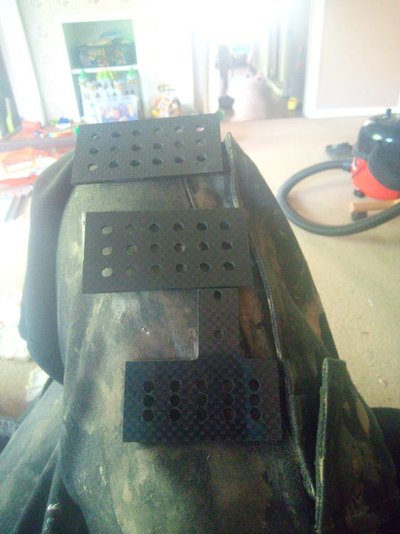
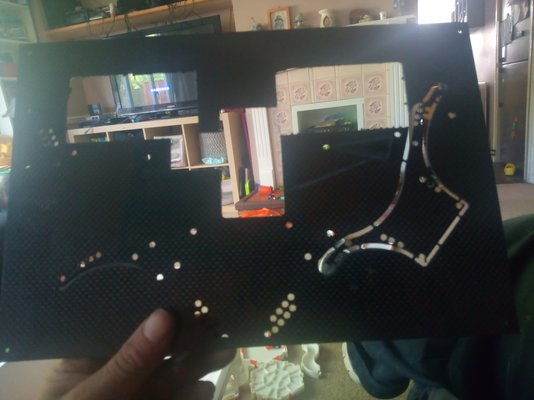
Pocket holes went well.
Workholding not so much.
4 holes around the outside and screwed down with double sided tape holding the middle.
Must have let go as the tabs were cut through on a middle piece.
Vibrated a bit loose and broke the bit.
Set up to have another go and forgot to swap to outside the line.
Spray glue. More CF and some new bits arriving tomorrow for another try


My Old Landy
Engineering Mayhem
- Messages
- 3,485
- Location
- North Lincs
Its looking good apart from that though!!Trials and tribulations.
Pocket holes went well.
Workholding not so much.
4 holes around the outside and screwed down with double sided tape holding the middle.
Must have let go as the tabs were cut through on a middle piece.
Vibrated a bit loose and broke the bit.
Set up to have another go and forgot to swap to outside the line.
Spray glue. More CF and some new bits arriving tomorrow for another try
View attachment 350642 View attachment 350643
eLuSiVeMiTe
Member
- Messages
- 16,282
- Location
- ......
Bushing in the z axis vibrated themselves out today. Gonna have to try and sort them out.Its looking good apart from that though!!
Get the feeling I'm gonna be upgrading in the not to distant future.
eLuSiVeMiTe
Member
- Messages
- 16,282
- Location
- ......
It's interesting what can be done with these machines, but they're never going to be a great machine, as they are built to a price.
Main thing I'd recommend them for, is learning the basics, and to guide people to what they actually want from a CNC router.
When you start upgrading them, you start entering the realm of chasing small gains, which are never going to result in a great machine, until you've replaced pretty much all the components.
You're far better to just built something from scratch, using good components, as you'll usually end up with a far better machine that requires far less tinkering to keep running well.
To give a basic list of what's needed to build what should be a reasonable machine-
Alu extrusion for frame and gantry (you can use steel for the frame, but you'd either have to bolt it to get some adjustability, or have it machined flat once welded).
Aluminium side plates (at this size of machine, 8mm or even 6mm would do, as they can still be cut reasonably easily with a jigsaw)
Linear rails (you ideally want something with medium preload - beware cheap rails are often zero preload, meaning you'll get movement between the rail/carriage under load, which can be quite noticeable once you allow for the leverage involved)
Ballscrews (rolled screws (C7 and over) with anti-backlash nut setups are usually OK, but ground (C5 and under) will reduce play, but extra cost can vary between minimal and make sure you're sitting down depending on size)
Proper ballscrew support bearings (even cheap C7 bearings will usually result in a noticeable improvement over the typical screw endfloat control on these machines.
Electrics/electronics wise, there are lots of options.
I could list pros and cons of lots of options, but if you're upgrading from one of these basic machines, swap the electronics, then upgrade/change as things break or you need/want more performance.
Main thing I'd recommend them for, is learning the basics, and to guide people to what they actually want from a CNC router.
When you start upgrading them, you start entering the realm of chasing small gains, which are never going to result in a great machine, until you've replaced pretty much all the components.
You're far better to just built something from scratch, using good components, as you'll usually end up with a far better machine that requires far less tinkering to keep running well.
To give a basic list of what's needed to build what should be a reasonable machine-
Alu extrusion for frame and gantry (you can use steel for the frame, but you'd either have to bolt it to get some adjustability, or have it machined flat once welded).
Aluminium side plates (at this size of machine, 8mm or even 6mm would do, as they can still be cut reasonably easily with a jigsaw)
Linear rails (you ideally want something with medium preload - beware cheap rails are often zero preload, meaning you'll get movement between the rail/carriage under load, which can be quite noticeable once you allow for the leverage involved)
Ballscrews (rolled screws (C7 and over) with anti-backlash nut setups are usually OK, but ground (C5 and under) will reduce play, but extra cost can vary between minimal and make sure you're sitting down depending on size)
Proper ballscrew support bearings (even cheap C7 bearings will usually result in a noticeable improvement over the typical screw endfloat control on these machines.
Electrics/electronics wise, there are lots of options.
I could list pros and cons of lots of options, but if you're upgrading from one of these basic machines, swap the electronics, then upgrade/change as things break or you need/want more performance.
eLuSiVeMiTe
Member
- Messages
- 16,282
- Location
- ......
That's my plan. Needed a reference to start from. For the £120 I paid it's giving me it's money worth both in functionality and experience.It's interesting what can be done with these machines, but they're never going to be a great machine, as they are built to a price.
Main thing I'd recommend them for, is learning the basics, and to guide people to what they actually want from a CNC router.
When you start upgrading them, you start entering the realm of chasing small gains, which are never going to result in a great machine, until you've replaced pretty much all the components.
You're far better to just built something from scratch, using good components, as you'll usually end up with a far better machine that requires far less tinkering to keep running well.
To give a basic list of what's needed to build what should be a reasonable machine-
Alu extrusion for frame and gantry (you can use steel for the frame, but you'd either have to bolt it to get some adjustability, or have it machined flat once welded).
Aluminium side plates (at this size of machine, 8mm or even 6mm would do, as they can still be cut reasonably easily with a jigsaw)
Linear rails (you ideally want something with medium preload - beware cheap rails are often zero preload, meaning you'll get movement between the rail/carriage under load, which can be quite noticeable once you allow for the leverage involved)
Ballscrews (rolled screws (C7 and over) with anti-backlash nut setups are usually OK, but ground (C5 and under) will reduce play, but extra cost can vary between minimal and make sure you're sitting down depending on size)
Proper ballscrew support bearings (even cheap C7 bearings will usually result in a noticeable improvement over the typical screw endfloat control on these machines.
Electrics/electronics wise, there are lots of options.
I could list pros and cons of lots of options, but if you're upgrading from one of these basic machines, swap the electronics, then upgrade/change as things break or you need/want more performance.
It's been on my to do list for years so I'm just pleased to be heading in the rigt direction.
It's a good plan.That's my plan. Needed a reference to start from. For the £120 I paid it's giving me it's money worth both in functionality and experience.
It's been on my to do list for years so I'm just pleased to be heading in the rigt direction.
I've seen far too many people chasing perfection with these kind of machines, and with the amount of time/money/wasted materials they spend, they could have just built a better machine from scratch.
eLuSiVeMiTe
Member
- Messages
- 16,282
- Location
- ......
It will be the groundwork to an 8x4 machine when I have the room.It's a good plan.
I've seen far too many people chasing perfection with these kind of machines, and with the amount of time/money/wasted materials they spend, they could have just built a better machine from scratch.
Only been talking about it for the last 3 years.
All in this machine has cost me £160 il go no further other than the necessary to keep it running now.
It's limitations were clear before I bought it. But that one off job spured me on.
My problem is I ignored the type you have as just an engraver.It will be the groundwork to an 8x4 machine when I have the room.
Only been talking about it for the last 3 years.
All in this machine has cost me £160 il go no further other than the necessary to keep it running now.
It's limitations were clear before I bought it. But that one off job spured me on.
I purchased a second hand one but it had very limited electronics and not chains for wires etc.
I then found its not a workbee (as its got belts) and I think it's an Ox.
Still not cut anything with it..

Agroshield
Member
- Messages
- 6,242
... double sided tape holding the middle.
...Spray glue.
With screws, small ones more often will help more than one in each corner. The material can vibrate like a drum skin as it is being cut and the more nodes you have with the closer screw spacing, the better.
A greater number, but smaller size tabs can help. Put a pause in the program and screw down the bit to be released before the final pass severing the tabs.
The raw MDF base might not be good for adhesion. If it is sealed so it is less porous, that could improve things. Melamine covered chipboard placed on top of the sub-base will give you a sealed surface. The shiny coated hardboard that forms the back of self-assembly wardrobes does the same and is thinner. Once glued or taped, go over it with a silicon roller to promote adhesion.
I have bought A4-size sheets of double-sided sticky which can work better than standard 50mm wide tape. If you have time, it can be beneficial to glue a piece of paper to the back of your material with water-based glue and then stick the lot down to the bed. Then it removes easier when you want it to and cleans up well (like soluble supposrts in 3DP).
eLuSiVeMiTe
Member
- Messages
- 16,282
- Location
- ......
eLuSiVeMiTe
Member
- Messages
- 16,282
- Location
- ......

